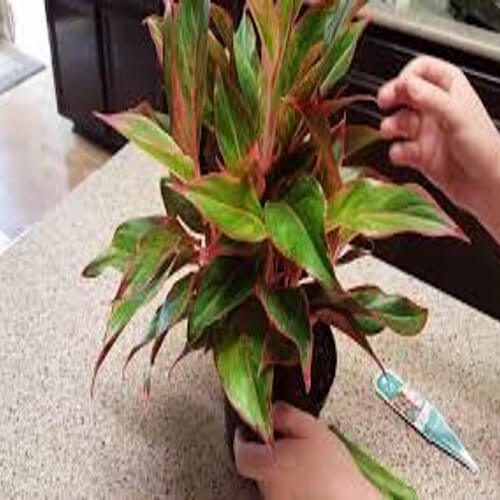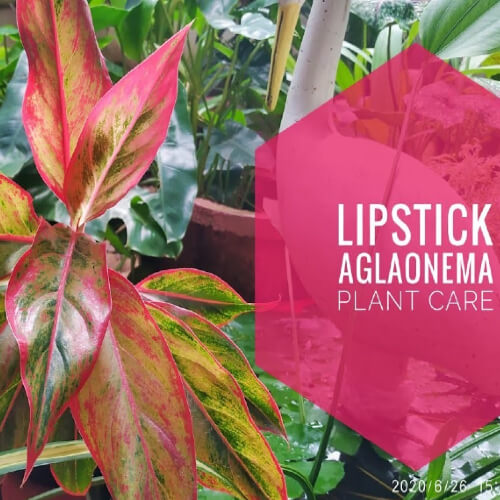Aglaonema Red Lipstick
Aglaonema Red Lipstick Plant popularly known as Chinese evergreen is one of the most stylish indoor plants and is very easy to grow. This native Asian plant has large yet narrow and oval-shaped leaves with a glossy finish. The striking red or pink tones in the foliage make it perfect for home and office décor.
Aglaonema Red Lipstick Benefits
The Aglaonema Red Lipstick (Chinese Evergreen) helps to improve the air quality of indoor spaces with the ability to filter indoor air pollutants and toxins. Furthermore, this gorgeous leafy indoor plant emits Oxygen, which assists in increasing productivity and enriching health and well-being both in living and working spaces.
Light & Temperature


Most common advice for the Aglaonema Red Lipstick Plant is, darker the leaves and stalks, the less light is needed. It would be safe to keep it in a bright room with the plant sitting in a shaded spot. Avoid direct sunlight; the darker green varieties of aglaonema can grow in near shade, while the variegated varieties require brighter light. Do not expose any variety of aglaonema to direct sun. These plants do not like cold drafts or temperatures below 15 degrees Celsius, lower than that is not healthy for this plant and can cause dark patches on the leaves. Be sure to keep it away from draft windows or vents and the warmer the spot you can find, the better. Temperatures between 18 degrees Celsius to 27 degrees Celsius are ideal.
Watering & Humidity


Water your Aglaonema Red Lipstick Plant when the top 50% of the soil is dry. Water until liquid flows through the drainage hole at the bottom of the pot and discard any water that has accumulated in the saucer. This plant can survive in a low humidity environment, but it will thrive with higher humidity levels. Mist the leaves regularly using a Mister to raise the humidity, especially during the drier winter months.
Soil & Fertilization


A peat based potting soil mixed with part perlite or sand to improve drainage is ideal or any other well-draining potting mix. A lightly acidic potting soil is perfect for aglaonemas. Feed your Aglaonema Red Lipstick Plant with slow-release pellets or liquid fertilizer during the growing season. From spring until the end of summer they like to be fed with a diluted liquid fertilizer.
Repotting Aglaonema Red Lipstick Plant
Chinese evergreens don’t mind being a little rootbound, but once your plant becomes too crowded with roots poking out of the drainage holes, that means it’s time to transplant. This is best done during the spring or summer when the plant is actively growing. Choose a pot that’s 3 to 4 inches wider than the current container and line it with fresh soil. Gently loosen your plant around the edges with your hand or a slim garden trowel and wiggle it free from the container. Place it in the new pot, top with fresh soil, and give it a nice drink of water.
Quick Tips for Aglaonema Red Lipstick Plant Care
- Mealybugs or scales may hide under stems and leaves. To remove the pests, use a spray bottle of water or wipe the insects off gently with a bit of rubbing alcohol on a paper towel or cotton swab. Repeated applications will be necessary to remove the pests’ offspring. If the plant is too heavily infested, it may be better to take a clean cutting from it and start anew.
- Root rot is caused by excessive moisture in the soil. Let the soil dry out between watering’s.
- Plant drooping are signs of a thirsty plant in need of more frequent or deeper watering’s. Dry and parched soil causes the plant to lose its natural stiffness and droop.
- All-over yellowing & squishy leaves indicates that the plant is getting too much water. Take it easy on the water level and let the soil dry out more in between.
- Dry Leaf Tip indicates that there’s a growing problem with your Aglaonema Red Lipstick Plant . This is called “tipping,” and it can be a symptom of a few issues, including overwatering and too much fertilizer. Professional gardeners have determined that the most common cause of tipping is watering your plant with water that has a high concentration of salts, chlorine, and fluoride. If your plant is showing signs of tipping, switch to purified water.





